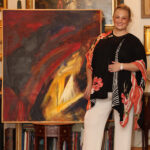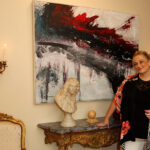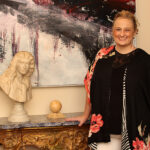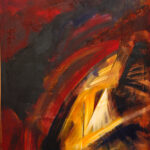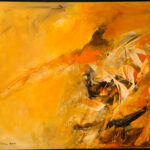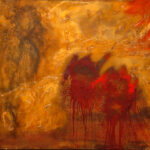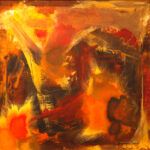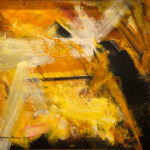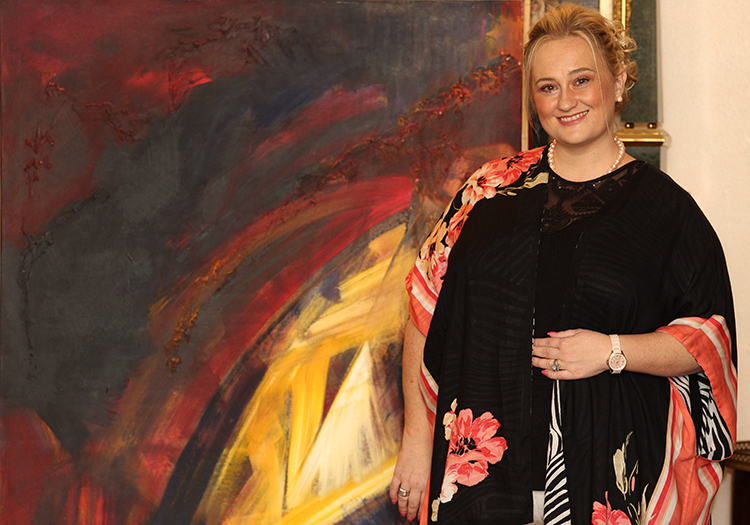
Although opera soprano Suzanne Clune says she has been singing all her life, it wasn’t until she turned 40 that she found her true voice.
An energetic and enthusiastic woman, Clune was teaching classical music at colleges near her home in Hudson Valley, New York, when she began pursuing a master’s degree at Columbia University. Almost on a whim, she took a painting class. “I had no inkling that I could paint,” says Clune.
“It just blossomed; it was so easy, so much fun. I got so much response.”
Right from the start, says her husband Werner Schmidt, it was apparent that she had “something.”
He recalls that she would bring home unfinished class projects on brown wrapping paper, and he was captured by their beauty. And, he says, in one noticeable way, she really stood out among her peers in group exhibitions.
While her classmates had painted small works of art, Clune preferred to go large and bold.
“I was speechless,” says Schmidt. “(She had) paintings up to the ceiling, huge paintings, 5 by 6 feet. Absolutely beautiful.”
The lid had been let off. Art seemed to pour out of her. Clune says she painted every day, in the middle of the night and into the wee hours. Two years zipped by, and she sold her first painting to a collector. She recalls being both elated and in a state of disbelief.
That same year, her work caught the attention of the National Association of Women Artists, which inducted her in 2015 into the esteemed society.
The recognition seemed to come from nowhere, Clune says. It catapulted not only her self-confidence, but through the society her works gained recognition by big-name Manhattan museums including the Whitney Museum of American Art, the Museum of Modern Art, the Guggenheim and the Metropolitan Museum of Art.
“I’m still very surprised, shocked,” she says. “It was tremendous. They project (your art) onto a screen, they name you and you get to come up and speak. That’s when I was really blown away. I was suddenly nervous. Now I have to talk about art. Give me a piece of music and I’ll sing it.”
Grand gestures inhabit Clune’s paintings. Just as with music, movement works in concert with smart composition and exciting color palettes. Since moving to Vero Beach in 2020, her works are already catching the eye of local collectors.
“She’s a wonderful artist,” says part-time Vero Beach resident Jay Grutman, an art and antiques collector. “Her artwork is very vibrant and really, at least what I’ve found, capture a person’s inner thoughts, inner feelings. And she’s got a fantastic (singing) voice.”
Scott Johnson, a local interior designer and decorator, has also purchased some of her paintings and, says Johnson, “I will probably buy more. I like to support local artists and I think she’s pretty stellar.”
Of course, music has continued to be an important part of Clune’s life, and she still occasionally performs. Additionally, she and Schmidt run an online antiques business, Clune Art and Antiques Studio, which caters to clients the world over.
Intriguingly, for someone with a deep background in classical music and pedigreed antiques, it is through abstract expressionism that she reveals her true self.
“It was very, very liberating,” Clune says. “I realized I was painting my feelings.”
While there is that “vital impulse” of self-expression in classical singing, there are also many constraining demands, such as vocal technique and breath control, the orchestra and composer, words and phrasing and even costumes.
Whereas with painting, Clune says, she can go as fast or slow as she wants. She can curl up on a stool, go barefoot and just be her true self.
And, she says, she can be “honest,” adding that the hardest part is knowing when the painting is finished. “It’s more turning myself inside out to show what’s in there,” Clune explains.
“We’re all dark. We’re the same. Being human and connecting with others requires openness.”
This feeling of openness was a long time coming for Clune, who shares that she was “painfully shy” as a child and teenager. Music helped bring her out of a protective shell, kept her connected to society and gave her support. Encouraged by her grandmother, she sang at church and in school and began taking lessons at age 7.
“It was a tool, a life raft,” she says.
Moreover, music opened the doors to a much bigger world than that of a childhood spent in upstate New York, where she didn’t have access to high culture. As a result, she relied on her vocal teachers, who took her under their wings and introduced her to Manhattan and, more importantly, to the opera.
“I was at the Met, and I saw Kathleen Battle sing Pamina from ‘The Magic Flute,’” she says. “I was 17.”
But, despite decades of devotion to music, Clune discovered that painting releases an even deeper, more authentic voice. “It’s hard to be your own thing, to find your own voice in this narrow hallway,” she says. “For my painting, it’s really my feelings out there, on the canvas. I almost feel like I’m moving the paintings, dancing. I’m going like a bat out of hell. I’m on fire.”
Clune says she prefers working with acrylics on stretched canvas, and will use brushes, her fingers, plastic scoops and various other items. But no music, she says, finding it too distracting.
“Usually I like it quiet. When I get stuck sometimes, I turn on music. For the most part I don’t like music when I’m creating.”
The same eagerness to follow her impulse that introduced her to art, also brought Clune and Schmidt to Vero Beach last year.
At the start of COVID Schmidt says she woke up in the middle of the night and said to him, “Werner, what do you think if we move to Florida?”
“Six weeks later, we were on the road. We didn’t know anybody (here). We rented a house sight unseen. That is Suzanne.”
Photos by Kaila Jones

